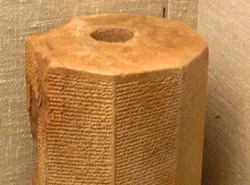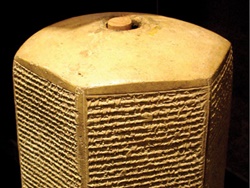Print Article
Author's Bias | Interpretation: conservative | Inclination: dispensational | Seminary: none
Known singularly as the Sennacherib prism or by its contents as the Annals of Sennacherib, three nearly
identical inscribed hexagonal clay prisms share the same account of Sennacherib king of Assyria's eight military
campaigns: the Taylor Prism (British Museum), Oriental Institute Prism (Oriental Institute of Chicago) and
Jerusalem Prism (Israel Museum in Jerusalem).
Son of king Sargon II, Sennacherib (Akkadian: Sin-akhkheeriba, reign: 705 – 681 B.C.)
received an Assyrian empire that extended westward to include Babylonia, to the border of Egypt and part of
Asia Minor. Beset by the influences of rising chieftains, Sennacherib spent much of his time reasserting control
over his vassal states Babylon and Judah. Besides his military success, Sennacherib would be known for his
building construction of his capital city Nineveh.
|
Taylor Prism |
Oriental Institute Prism |
Jerusalem Prism |
| Height |
38.1 cm (15 in) |
38 cm (15 in) |
31 cm (12.25 in) |
| Width (max) |
16.51 cm (6.5 in) |
14 cm (5.5 in) |
17 cm (6.75 in) |
| Width (min) |
8.57 cm (3.5 in) |
|
|
| Recovery Location |
Tell Nabī Yūnus (modern day Mosul Iraq) |
Tell Kouyunjik (modern day Mosul Iraq) |
Ancient Nineveh (modern day: Mosul Iraq) |

Jerusalem Prism
|

Taylor Prism
|

Oriental Institute Prism |
Made approximately around 690 B.C., all six sides of the hexagonal prism were inscribed with Assyrian cuneiform
totaling some 500 lines. Significant to the Bible is Sennacherib's third military campaign (701 B.C.) in which the
Assyrian army, while suppressing Judah, besieges king Hezekiah in Jerusalem.
In response to Hezekiah's rebellion (2 Ki 18:7),
Sennacherib seizes Judah by destroying its cities and deporting its surviving Jews. The defeat of the fortified
city of Lachish was significant to Sennacherib and was recorded on a
massive wall relief
(width: 80 feet, height: 8.25 feet) depicting the construction of siege ramps, archers and warriors slinging
stone and spears.
The Assyrian view of Sennacherib's third military campaign can be seen in this translation of
a section of inscriptions:
Sennacherib, the great king, the mighty king, king of the world, king of Assyria, king
of the four quarters, the wise shepherd, favorite of the great gods, guardian of right, lover of justice, who
lends support, who comes to the aid of the destitute, who performs pious acts, perfect hero, mighty man, first
among all princes, the powerful one who consumes the insubmissive, who strikes the wicked with the thunderbolt;
the god Assur, the great mountain, an unrivaled kinship has entrusted to me, and above all those who dwell in
palaces, has made powerful my weapons; from the upper sea of the setting sun to the lower sea of the rising sun,
he has brought the black-headed people in submission at my feet; and mighty kings feared my warfare, leaving their
homes and flying alone, like the sidinnu, the bird of the cave, to some inaccessible place...
As for Hezekiah the Judahite, who did not submit to my yoke: forty-six of his strong,
walled cities, as well as the small towns in their area, which were without number, by levelling with battering-rams
and by bringing up siege-engines, and by attacking and storming on foot, by mines, tunnels, and breeches, I besieged
and took them. 200,150 people, great and small, male and female, horses, mules, asses, camels, cattle and sheep
without number, I brought away from them and counted as spoil. (Hezekiah) himself, like a caged bird I shut up in
Jerusalem, his royal city. I threw up earthworks against him— the one coming out of the city-gate, I turned back
to his misery. His cities, which I had despoiled, I cut off from his land, and to Mitinti, king of Ashdod, Padi,
king of Ekron, and Silli-bêl, king of Gaza, I gave (them). And thus I diminished his land. I added to the former
tribute, and I laid upon him the surrender of their land and imposts—gifts for my majesty. As for Hezekiah, the
terrifying splendor of my majesty overcame him, and the Arabs and his mercenary troops which he had brought in to
strengthen Jerusalem, his royal city, deserted him. In addition to the thirty talents of gold and eight hundred
talents of silver, gems, antimony, jewels, large carnelians, ivory-inlaid couches, ivory-inlaid chairs, elephant
hides, elephant tusks, ebony, boxwood, all kinds of valuable treasures, as well as his daughters, his harem, his
male and female musicians, which he had brought after me to Nineveh, my royal city. To pay tribute and to accept
servitude, he dispatched his messengers…
Historically it is worth noting that the walls of Jerusalem were never breached. Assyrian
historians portray Sennacherib as having Hezekiah as a prisoner, “like a caged bird I shut up in Jerusalem"; but,
Jerusalem was never listed among the cities successfully conquered. Hezekiah not only survived the assault of
Jerusalem, he also witnessed the route of Sennacherib's besieging army
(2 Chron 32:20-21).
Sennacherib figures prominently in the Old Testament having his name recorded some fourteen times. The Annals
of Sennacherib provide extrabiblical corroboration of the Old Testament accounts that provide greater detail of
the Assyrian invasion.
Hezekiah prepares for Sennacherib assault
(2 Chron 32:1-8).
After the fortified city of Lachish has fallen, Sennacherib's representative began their
psychological assault of Jerusalem in attempt to secure a surrender of Hezekiah
(2 Ki 18:20-37; 2 Chron 32:9-19;
Isa 36:1-22).
With penitence and mourning, Hezekiah prays and beseeches God for salvation, and God answers
through the prophet Isaiah (2 Ki 19:1-34;
2 Chron 32:20; Isa 37:1-35).
Sennacherib's forces were defeated, and Jerusalem was saved
(2 Ki 19:35-36; 2 Chron 32:21-22;
Isa 37:36-38).
References:
1. Luckenbill DD, The Annals of Sennacherib, Chicago: University of Chicago Press (1924).
2. Ling-Israel P, "The Sennacherib Prism in the Israel Museum—Jerusalem," in Bar-Ilan: Studies in Assyriology Dedicated to Pinḥas Artzi, ed. Klein J and A. Skaist A, eds., Ramat-Gan: Bar-Ilan University Press (1990).
3. From the website: Britishmuseum.org, "The Taylor Prism / The Sennacherib Prism / Library of Ashurbanipal".
Copyright ©
2018
Helpmewithbiblestudy.org. All rights to this material are reserved. We encourage you to print the material for personal and
non-profit use or link to this site. If you find this article to be a blessing, please share the link so that it may rise in
search engine rankings.